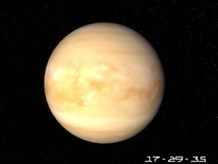Last week I took a look at one of the methods which astronomers use to find planets around stars. I discussed the Stellar Wobble technique, which is what in the past has been used to hunt for extra solar planets. There are a few drawbacks to this method. One of the drawbacks is that it is tedious; one has to keep returning to this star and measure the motion. The other drawback is the cost, it is expensive to take the spectra and see the red and blue shifts. There is no other way in which to obtain the information. Therefore, the transit method is a way that one can determine if there may be a planet that is orbiting a star. One can find the size of the planet though this method. This method is less tedious and also cheaper. One only has to take a picture with a telescope and see if the brightness of the star has changed. The transit method is a method that measures the dimming effect a planet will have on the star when the planet passes in front of the star. This dimming effect is not a large one but with the technology we have one can determine this low amount of dimming. Kepler is a satellite that is in orbit right now and it is looking at the same patch of sky day after day and is looking for this effect. It has found a large number of possible planets around stars since it has been launched. The figure below shows the transit method.
 |
Figure obtained from: http://www.jodcast.net/archive/201107Extra/ |
Like every method there are disadvantages. Some of these included that these transits are only observable for planets whose orbits are aligned with the observer. Another disadvantage is that this method can suffer from false detections. For example the find a two star system or the star has the equivalent of our stars sun spots. This can make the results seem to be a planet but it is false. This means that there has to be another technique to determine if there is in fact a planet. This is where if the Stellar Wobble and the Transit Method are partnered together then it would save money and time. The transit method could be used to find possible extrasolar planets and then the stellar wobble would be able to confirm that they are in fact planets. This means that the expensive method would only be used on stars that have evidence for an orbiting planet.
Information obtained from:
http://novacelestia.com/space_art_extrasolar_planets/detect_extrasolar_planets.html
http://novacelestia.com/space_art_extrasolar_planets/detect_extrasolar_planets.html




